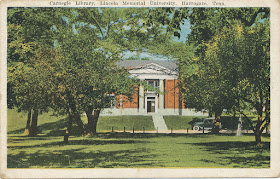This blog represents a collection of postcards that focuses on libraries in the United States and throughout the world.
Pages
▼
Wednesday, October 25, 2017
Monday, February 20, 2017
Friday, February 17, 2017
Friday, February 10, 2017
Monday, January 30, 2017
Carnegie Library, Stevens Point, Wisconsin, 1922
1904 - June 1: The first public-library building, funded with $21,000 from Andrew Carnegie, is dedicated. A typical Carnegie library, with a large dome and Roman columns, it stands at the northeast corner of Clark Street and Strongs Avenue until 1968, when it is razed. Only its bronze front-doors and lamp-posts—added in 1918 with a bequest from Andrew R. Week, a wealthy local lumberman--are salvaged, and are eventually incorporated into the third (1992) public library.
Saturday, January 28, 2017
Calumet & Hecla Library, Calumet, Michigan
LIB980280
Almost a full decade before Carnegie money found its way to the Copper Country, it was financial support from another capitalist with more local ties that brought the first dedicated library building to the region. That man was Alexander Agassiz, president of the Calumet and Hecla Mining Company. Like Carnegie, Agassiz was an immigrant from humble beginnings that by happenstance and hard work was able to take advantage of the industrial transformation of the country to garner himself great power and wealth. As president of the great C&H Empire, Agassiz leveraged his company’s wealth and prestige to keep his workforce as content as possible through an industrial governance known as paternalism. Towards that goal the company provided its workforce with cheap housing, public baths at its bathhouse, free healthcare through its hospital, and assisted in the erection of churches on company property. In 1896 the company added yet another fringe benefit to its offerings – a public library. [http://www.coppercountryexplorer.com/2014/02/the-calumet-and-hecla-library/]








































